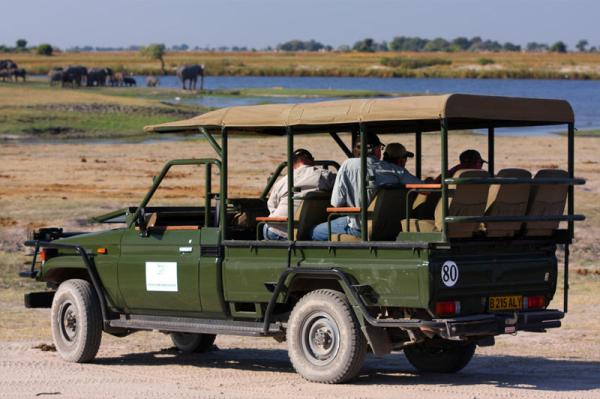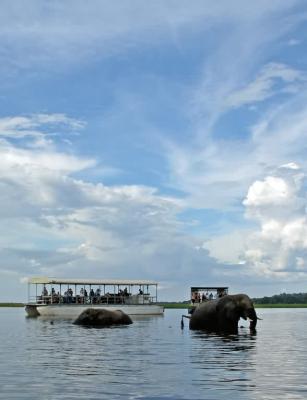The Chobe National Park, which is the second largest national park in Botswana and covers 11 700 square km, has one of the greatest concentrations of game found on the African continent. Its uniqueness in the abundance of wildlife and the true African nature of the region, offers a safari experience of a lifetime.
Chobe National Park encompassing floodplains, swamps and woodland. The Chobe River forms its northern boundary.
There are four distinct geographical areas in the park:
- the Chobe Riverfront
- the Ngwezumba pans
- Savut
- Linyanti.
Accommodation
Options for accommodation in Chobe National Park comprise luxury safari lodges:
Exploring ChobeThe area can be explored via one of the multi-day
Botswana Safaris. Fly-in safaris are undertaken to wilderness camps in
Linyanti.
The AreaThe most accessible and frequently visited of Botswanas big game parks, the
Chobe Riverfront is most famous for its large herds of elephants and cape Buffalo, which during the dry winter months converge upon the river to drink.
Sandwiched between the Chobe National Park to the east and the Okavango south, the extensive
Linyanti concession offers superb wildlife viewing and terrain to rival the physical beauty of the Okavango.
Geographically, Savut is an area of many curiosities. One of its greatest mysteries is the Savut channel itself, which has over the past 100 year inexplicably dried up and recommenced its flow several times.
The Ngwezumba pans lie approximately 70 kms south of the Chobe River and comprise a large complex of clay pans, surrounded by mophane woodlands and grassland plains.
ElephantsA major feature of Chobe National Park is its elephant population currently estimated at around 120,000. The Chobe elephant are migratory, making seasonal movements of up to 200 km from the Chobe and Linyanti rivers, where they concentrate in the dry season, to the pans in the southeast of the park, to which they disperse in the rains.
Savute The Savut channel flows from the Linyanti River for about 100 kilometres, carrying water away from the river and releasing it into a vast swampland called the Savut Marsh, and further south onto the Mababe Depression.
Often described as one of, if not the best, wildlife-viewing area in Africa today. Savute boasts one of the highest concentrations of wildlife left on the African continent. Animals are present during all seasons, and at certain times of the year their numbers can be staggering.
If you allow yourself adequate time here (a minimum of three to four days is recommended) you will probably see nearly all the major species: giraffe, elephant, zebra, impala, tsessebe, roan, sable, wildebeest, kudu, buffalo, waterbuck, warthog, eland and accompanying predators including lion, hyena, jackal, bat-eared fox and possibly even cheetah and wild dog.
Savute is famous for its predators, particularly its resident lions and spotted hyena populations.
Please Note mosquitoes are prevalent throughout the park and visitors are strongly advised to take anti-malarial prophylactics.





